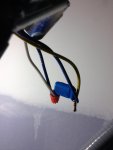grasfulls
Always tired, so cannot retire
- Location
- Placer County. CA
- Occupation
- Professional inane question maker
I will be installing LED undercabinet lighting where the driver requires a minimum 60% load. Not a problem EXCEPT one standalone cabinet on its own switch and using only 4.18 watts, min driver size = 10W. Manufacturer wants me to use a Lutron synthetic load (lottsa $ just to dim), I want to use a power resistor.
Can I do this?
What value (watts and ohms)?
Does it get wired in parallel to the load?
When I looked for power resistors I see several with 5 watt ratings but different resistance values, I do not understand that. Ignorance is not bliss.
LED tape = Diode LED Arhc24, 2.09Wperft
https://www.diodeled.com/avenue-24-premium-24v-led-tape-light.html
Driver = Omnidrive with 24vdc output
https://www.diodeled.com/custom/download/productFile/filename/DI-TD-Cut Sheet.pdf/
Can I do this?
What value (watts and ohms)?
Does it get wired in parallel to the load?
When I looked for power resistors I see several with 5 watt ratings but different resistance values, I do not understand that. Ignorance is not bliss.
LED tape = Diode LED Arhc24, 2.09Wperft
https://www.diodeled.com/avenue-24-premium-24v-led-tape-light.html
Driver = Omnidrive with 24vdc output
https://www.diodeled.com/custom/download/productFile/filename/DI-TD-Cut Sheet.pdf/


